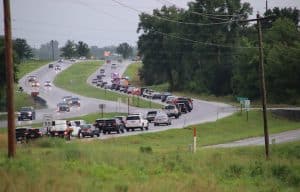Chasing the wind?
Gov. JB Pritzker signed HB 4412 into law Friday, potentially bringing wind energy back into play for Monroe County.
The bill standardizes the site selection and permit process for commercial endeavors regarding both wind and solar power.
The bill also established specific standards for height, setback, noise, “shadow flicker” and other aspects for implementation of wind turbines – the structures necessary to produce energy at a commercial level.
Supporters of the bill claim the changes were necessary to prevent Illinois counties from allowing any consideration of wind energy specifically, claiming the restrictions amounted to a denial of individual property rights and an a de facto ban on clean energy.
According to a synopsis of Public Act 102-1123, the legislation establishes “provisions limiting a county’s ability to regulate commercial wind energy facilities and commercial solar energy facilities.”
While Illinois counties may still adopt language regarding commercial wind facilities, they may not be “more restrictive” than the recently passed guidelines.
Monroe County Board Chairman Dennis Knobloch told the Republic-Times the county’s wind energy ordinance as passed in 2021 is more restrictive than the new state standards.
The new law gives such counties 120 days to pass a new ordinance to comply with updated regulations.
“Here are my concerns (with the new law),” Knobloch began. “I get nervous when the state decides it knows better than the local officials.”
While sponsors of the bill claim the specifics are based on “best practices” of Illinois counties which currently produce commercial wind and solar power, Knobloch disagrees.
He argued energy facility regulations are not “one size fits all,” considering they will be applied to “counties of all shapes and sizes” with varying population densities.
The Illinois Farm Bureau also took issue with the new wind energy law, stating it would negatively impact farmers and farmland.
An IFB official cited a lack of required enforcement of “agricultural impact mitigation agreements” as well as a lack of clarity regarding rainwater drainage and runoff plans needed with construction of wind turbines, according to a FarmWeek article published last week.
Wind energy became a hot topic in Monroe County in 2018 when a proposed plan was introduced by local developer Joe Koppeis to build a $200 million, 50-turbine wind farm near the bluffs south of Valmeyer.
As of press time, Koppeis had not responded to requests for comment about possible renewed interest in developing a wind facility in Monroe County in light of the new law.
One of the concerns with the 2018 proposal was the effect on the karst topography and wildlife along the turbine locations, although those considerations should still factor in determining appropriate locations for wind turbines if a new proposal is brought to Monroe County.
Knobloch said the new law still “allows input from outside agencies such as the Illinois Department of Natural Resources to consider inherent problems” which may accompany a wind farm development.
Knobloch concluded by saying he believes Monroe County will “still be OK,” although commissioners will be revisiting the county’s existing wind energy ordinance in the near future.






